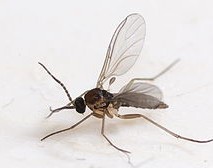
Fungus gnats look like tiny, black flies with grayish transparent wings. The adults are about 1/16-in (.2 cm) long and have long legs and antennae. Being so small, they can enter a home through the tiniest of openings. They sometimes arrive in a newly purchased bag of potting soil.
They’re more of an annoyance than anything. They are harmless to humans, and unlike many house plant pests, the adult gnats don’t feed on plants, but the larvae can. They’re attracted to moist organic matter such as peat moss and fir bark in many potting mixes, and overwatered plants will draw them…well, like flies. This is why they like to fly around your eyes because they are attracted to moisture. But they aren’t all bad. Fungus gnats are important pollinators, help decompose decaying organic matter and are used as food by other small animals including birds, reptiles and beneficial insect predators. Look for premium soil mixes that do not have wood as a fillers. You can find good soil from local organic gardening centers or bulk soil producers.
Now you’re wondering…why treat my plants? The fungus gnat life cycle is quick and they may take over your whole plant collection if left untreated. Most of these insects are females that will lay 100-300 eggs in crevices of the soil. The eggs hatch into larvae in 4-6 days and feed on plant roots, damaging your plants and leaving them susceptible to disease. After feeding for a couple weeks, they go through a pupal stage in the soil. In less than a week, they emerge as adults to begin the cycle all over again.
Controlling these insects can be as simple as allowing the soil to dry out between waterings. If your plant will tolerate dry soil for a short time, this may be the solution. I tried this on my heartleaf philodendron. I stopped watering it for 2 weeks to let the soil dry out and the gnats just disappeared. The dry-growing medium will decrease survival of any eggs laid and/or larvae that hatch from the eggs as well as reduce the attractiveness of the growing medium to egg-laying adult females. If your plant is not drought-tolerant, try one of the other solutions. Keep plants clean of fallen leaves and debris. Fungus gnats feed on dead plant material.
Applying a thin layer of sand on the top of the soil can help because sand dries out quickly and the adults will not want to lay eggs on the sand.
You can catch the adult insects by laying a yellow sticky trap on top of the soil in each infested plant container. This will catch the adults, but not the larvae. Insecticidal soaps labeled for fungus gnats can be used for killing the adult insects.
Knock-out gnats contains Bacillus thuringiensis (Bt-H14), a safe, effective way for killing gnat larvae on house plants. Apply as needed to stop the life cycle. Read the label carefully and follow the manufacturer’s directions for use. You can find it in products specifically made for gnat control like Knock Out Gnats or Gnatrol. In a pinch, you can make your own by buying a package of mosquito dunks as I did (same BTi), floating a dunk in a container of water overnight, then using that water to water your plants.
Drench the soil with a solution of pyrethrin, an organic pesticide made from chrysanthemums.
Microscopic worms called nematodes that attack fungus gnat larvae, can be purchased at a local organic gardener or online and arrive in powder packets or from a local organic gardening center. The solution is mixed into your watering application and within days, as the plants consume the water, the nematodes feast on gnat eggs in the soil. You can even inject the solution directly into plants or apply with spray equipment. Most parasitic nematodes packaged for sale have a shelf life of several weeks or even months if refrigerated.
An effective means of detecting the presence of fungus gnat larvae is to insert 1/4 inch slices or wedges of potato into the growing medium. Larvae will migrate to the potato and start feeding within a few days. The potato slices should be turned over to look for larvae present on the underside.


